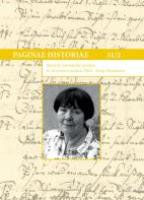Bedřich Jenšovský a Řím
Bedřich Jenšovský and Rome
Author(s): Alena PazderováSubject(s): History, Archiving, Interwar Period (1920 - 1939)
Published by: Národní archiv
Keywords: archivists; editors; Vatican Archives; Italian archives; scientific institutions; Academy of Sciences of the Czech Republic, Historical Institute
Summary/Abstract: Based on the travel reports of Dr Bedřich Jenšovský, providing a vivid testimony of his daily work in Rome, yet to be fully used, the study charts his five sojourns to Rome from the eve of the First World War to the 1920s and 1930s. Jenšovský is not only presented as a prominent researcher and connoisseur of the Vatican Apostolic Archives, Vatican Apostolic Library, and other Italian archives and libraries but also as an experienced editor and author of the third volume of the series Monumenta Vaticana res gestas bohemicas illustrantia. Moreover, he was an assiduous heuristic and editorial contributor to other volumes in the series (Tomus prodromus, vols. VI and VIII) that later editors successfully continued. His research of Bohemica in Italian and Vatican libraries was of no less import; his study about the Barberini Library laid foundations for their scientific analyses. His heuristic works on the research of the nunciature at the imperial court in the late 16th and the first quarter of the 17th centuries were equally significant and serve current editors of the nunciature editions. The enormous diligence, systematic character, and dutifulness of Jenšovský’s research are further evidenced by a wide array of remaining copies of the Vatican and Italian documents in the National Archives, today also used as erudite sources for historians and researchers of the Middle Ages and early modern times. In the 1920s and 1930s, Jenšovský mingled with the masterminds of the newly established Czechoslovak Historical Institute in Rome that he chaired during his sojourns there and he worked at full capacity on its organisation, scientific tasks, and international presentation, often with the assistance of the Czechoslovak ambassadors to Italy and the Vatican. It was also thanks to his initiatives that the institute could boast about successful collaboration with foreign historical institutes accredited in Rome (especially the Austrian, German, Romanian, and the Görres Society) as well as with Italian institutes (Istituto per l’Europa Orientale, Assoziatione per gli studi mediterranei, Annales Institutorum, Istituto di Studi Romani), by participating in their conferences and sessions. Furthermore, Jenšovský paid great attention to the proper operation of the Czechoslovak Historical Institute in Rome, both the organisational and administrative aspects, as documented by his efforts to develop the institute’s status, care for its registry, whose plan he drew up in 1930, and he also put extended efforts into the cataloguing and continuous re-stacking of the institute’s library. His great, though unfulfilled dream was the establishment of the Czechoslovak Academy in Rome. Fortunately, he did not live to see the sad end of the Czechoslovak Historical Institute in Rome, to whose administration he devoted such a great deal of effort. Nonetheless, his legacy continues in the newly established Czech Historical Institute in Rome that actually has implemented many of Jenšovský’s ideas that were on a waiting list for more than half a century.
Journal: Paginae Historiae
- Issue Year: 31/2023
- Issue No: 2
- Page Range: 344-375
- Page Count: 32
- Language: Czech

